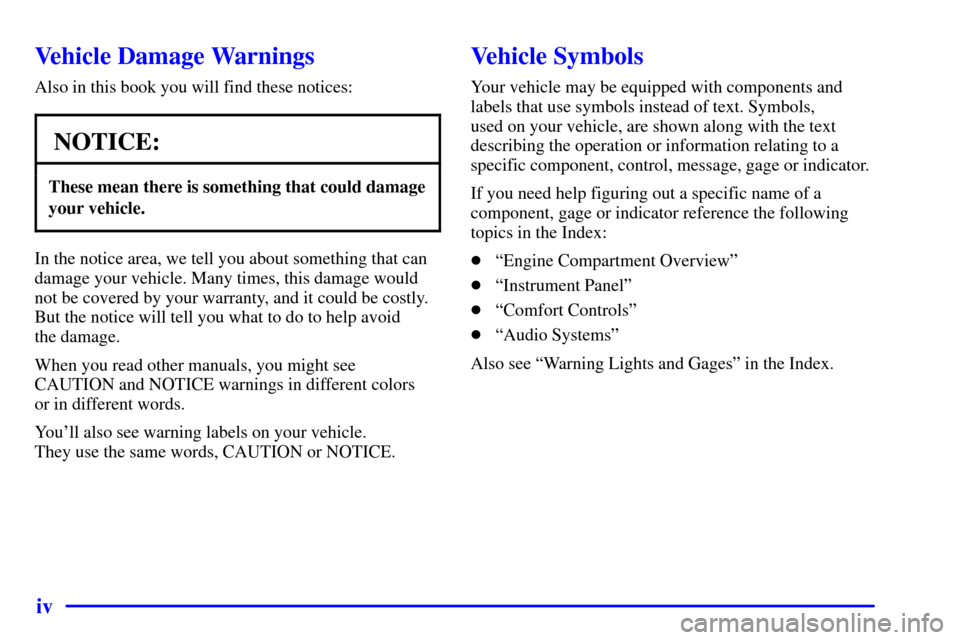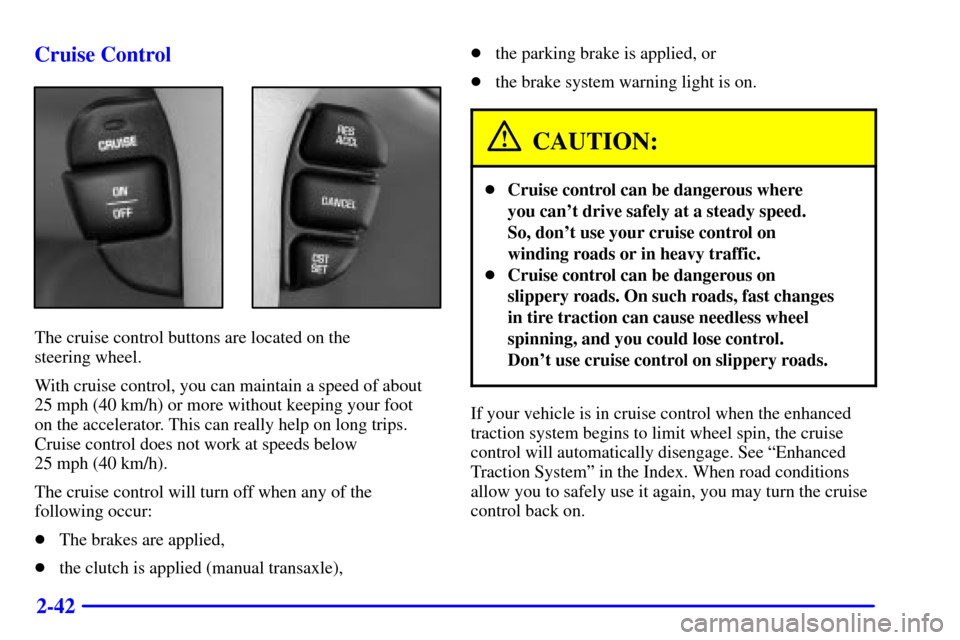Page 5 of 343

iv
Vehicle Damage Warnings
Also in this book you will find these notices:
NOTICE:
These mean there is something that could damage
your vehicle.
In the notice area, we tell you about something that can
damage your vehicle. Many times, this damage would
not be covered by your warranty, and it could be costly.
But the notice will tell you what to do to help avoid
the damage.
When you read other manuals, you might see
CAUTION and NOTICE warnings in different colors
or in different words.
You'll also see warning labels on your vehicle.
They use the same words, CAUTION or NOTICE.
Vehicle Symbols
Your vehicle may be equipped with components and
labels that use symbols instead of text. Symbols,
used on your vehicle, are shown along with the text
describing the operation or information relating to a
specific component, control, message, gage or indicator.
If you need help figuring out a specific name of a
component, gage or indicator reference the following
topics in the Index:
�ªEngine Compartment Overviewº
�ªInstrument Panelº
�ªComfort Controlsº
�ªAudio Systemsº
Also see ªWarning Lights and Gagesº in the Index.
Page 63 of 343

2-
2-1
Section 2 Features and Controls
Here you can learn about the many standard and optional features on your vehicle, and information on starting,
shifting and braking. Also explained are the instrument panel and the warning systems that tell you if everything is
working properly
-- and what to do if you have a problem.
2
-2 Windows
2
-4 Keys
2
-6 Door Locks
2
-11 Remote Keyless Entry System (If Equipped)
2
-15 Trunk
2
-18 Theft
2
-19 Passlock�
2-19 New Vehicle ªBreak-Inº
2
-20 Ignition Positions
2
-21 Starting Your Engine
2
-24 Engine Coolant Heater (Option)
2
-26 Automatic Transaxle Operation
2
-30 Manual Transaxle Operation
2
-32 Parking Brake
2
-33 Shifting Into PARK (P)
(Automatic Transaxle Only)
2
-35 Shifting Out of PARK (P)
(Automatic Transaxle Only)2
-35 Parking Your Vehicle/Key Removal
(Manual Transaxle Models Only)
2
-36 Parking Over Things That Burn
2
-36 Engine Exhaust
2
-37 Running Your Engine While You're Parked
(Automatic Transaxle)
2
-38 Tilt Wheel
2
-38 Turn Signal/Multifunction Lever
2
-45 Exterior Lamps
2
-48 Interior Lamps
2
-50 Mirrors
2
-52 Storage Compartments
2-53 Ashtray and Cigarette Lighter (If Equipped)
2
-53 Sun Visors
2
-54 Accessory Power Outlet
2
-55 Sunroof (Option)
2
-56 The Instrument Panel -- Your
Information System
2
-60 Warning Lights, Gages and Indicators
Page 82 of 343

2-20
Ignition Positions
With the key in the ignition switch, you can turn it to
four different positions.
A (OFF): This is the only position from which you can
remove the key. With an automatic transaxle, the shift
lever must be in PARK (P) with the ignition in OFF to
remove the key. With a manual transaxle, the shift lever
must be in REVERSE (R) with the ignition in OFF to
remove the key.A warning chime will sound if you open the driver's
door when the ignition is off and the key is in the
ignition.
NOTICE:
If your key seems stuck in OFF and you can't
turn it, be sure you are using the correct key; if
so, is it all the way in? Turn the key only with
your hand. Using a tool to force it could break
the key or the ignition switch. If none of this
works, then your vehicle needs service.
B (ACCESSORY): This position unlocks the transaxle.
It also lets you use things like the radio and windshield
wipers when the engine is not running. To use
ACCESSORY, turn the key clockwise to the first
position. Use this position if your vehicle must be pushed
or towed, but never try to push
-start your vehicle.
Page 83 of 343

2-21
C (ON): This position is where the key returns to after
you start your engine and release the key. The ignition
switch stays in ON when the engine is running. But even
when the engine is not running, you can use ON to
operate your electrical accessories and to display some
instrument panel warning lights.
D (START): This position starts the engine. When the
engine starts, release the key. The ignition switch will
return to ON for normal driving.
Retained Accessory Power (RAP)
Your vehicle is equipped with a Retained Accessory
Power (RAP) feature which will allow the radio to
continue to work up to 10 minutes after the ignition is
turned to OFF.
Your radio will work when the ignition key is in ON or
ACCESSORY. Once the key is turned from ON to OFF,
the radio will continue to work up to 10 minutes or until
the driver's door is opened.
Starting Your Engine
Automatic Transaxle
Move your shift lever to PARK (P) or NEUTRAL (N).
Your engine won't start in any other position
-- that's
a safety feature. To restart when you're already moving,
use NEUTRAL (N) only.
NOTICE:
Don't try to shift to PARK (P) if your vehicle
is moving. If you do, you could damage the
transaxle. Shift to PARK (P) only when your
vehicle is stopped.
Manual Transaxle
The gear selector should be in neutral and the parking
brake engaged. Hold the clutch pedal to the floor and
start the engine. Your vehicle won't start if the clutch
pedal is not all the way down
-- that's a safety feature.
Page 94 of 343
2-32
Parking Brake
Automatic Transaxle shown,
Manual Transaxle similar
To set the parking brake, pull up on the parking brake
handle. If the ignition is on, the brake system warning
light will come on.To release the parking brake, hold the regular brake
pedal down. Pull the parking brake handle up until you
can press the release button. Hold the release button in
as you move the brake handle all the way down.
NOTICE:
Driving with the parking brake on can cause
your rear brakes to overheat. You may have to
replace them, and you could also damage other
parts of your vehicle.
If you are towing a trailer and are parking on a hill, see
ªTowing a Trailerº in the Index. That section shows
what to do first to keep the trailer from moving.
Page 101 of 343

2-39 Turn and Lane-Change Signals
The turn signal has two upward (for right) and two
downward (for left) positions. These positions allow
you to signal a turn or a lane change.
To signal a turn, move the lever all the way up or
down. When the turn is finished, the lever will
return automatically.
An arrow on the instrument
panel cluster will flash in
the direction of the turn or
lane change.
To signal a lane change, just raise or lower the lever
until the arrow starts to flash. Hold it there until you
complete your lane change. The lever will return by
itself when you release it.As you signal a turn or a lane change, if the arrows
flash rapidly, a signal bulb may be burned out and
other drivers won't see your turn signal.
If a bulb is burned out, replace it to help avoid an
accident. If the arrows don't go on at all when you
signal a turn, check for burned
-out bulbs and then check
the fuse (see ªFuses and Circuit Breakersº in the Index).
Turn Signal On Chime
If your turn signal is left on for more than 3/4 of a mile
(1.2 km), a chime will sound at each flash of the turn
signal. To turn off the chime, move the turn signal lever
to the off position.
Lamps On Reminder
If you open the driver's door and turn off the
ignition while leaving the lamps on, you will hear
a warning chime.
Page 104 of 343

2-42 Cruise Control
The cruise control buttons are located on the
steering wheel.
With cruise control, you can maintain a speed of about
25 mph (40 km/h) or more without keeping your foot
on the accelerator. This can really help on long trips.
Cruise control does not work at speeds below
25 mph (40 km/h).
The cruise control will turn off when any of the
following occur:
�The brakes are applied,
�the clutch is applied (manual transaxle),�the parking brake is applied, or
�the brake system warning light is on.
CAUTION:
�Cruise control can be dangerous where
you can't drive safely at a steady speed.
So, don't use your cruise control on
winding roads or in heavy traffic.
�Cruise control can be dangerous on
slippery roads. On such roads, fast changes
in tire traction can cause needless wheel
spinning, and you could lose control.
Don't use cruise control on slippery roads.
If your vehicle is in cruise control when the enhanced
traction system begins to limit wheel spin, the cruise
control will automatically disengage. See ªEnhanced
Traction Systemº in the Index. When road conditions
allow you to safely use it again, you may turn the cruise
control back on.
Page 119 of 343
2-57
The main components of your instrument panel are the following:
A. Instrument Panel Fuse Blocks
B. Vents
C. Instrument Panel Cluster
D. Hazard Warning Flasher Button
E. Audio System
F. Climate Control System
G. Side Window Defogger Vent
H. Fog Lamp Button (If Equipped)
I. Instrument Panel Brightness Thumbwheel
J. Turn Signal/Multifunction LeverK. Hood Release Handle
L. Cruise Control Switches
M. Tilt Wheel Lever
N. Ignition Switch
O. Windshield Wiper/Washer Lever
P. Enhanced Traction System Button
Q. Transaxle Shift Lever
R. Parking Brake
S. Cigarette Lighter/Accessory Power Outlet
T. Accessory Power Outlet